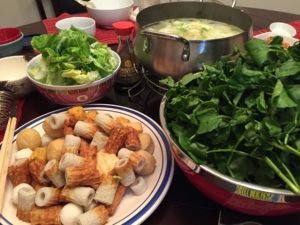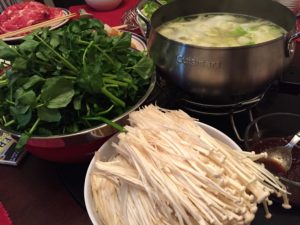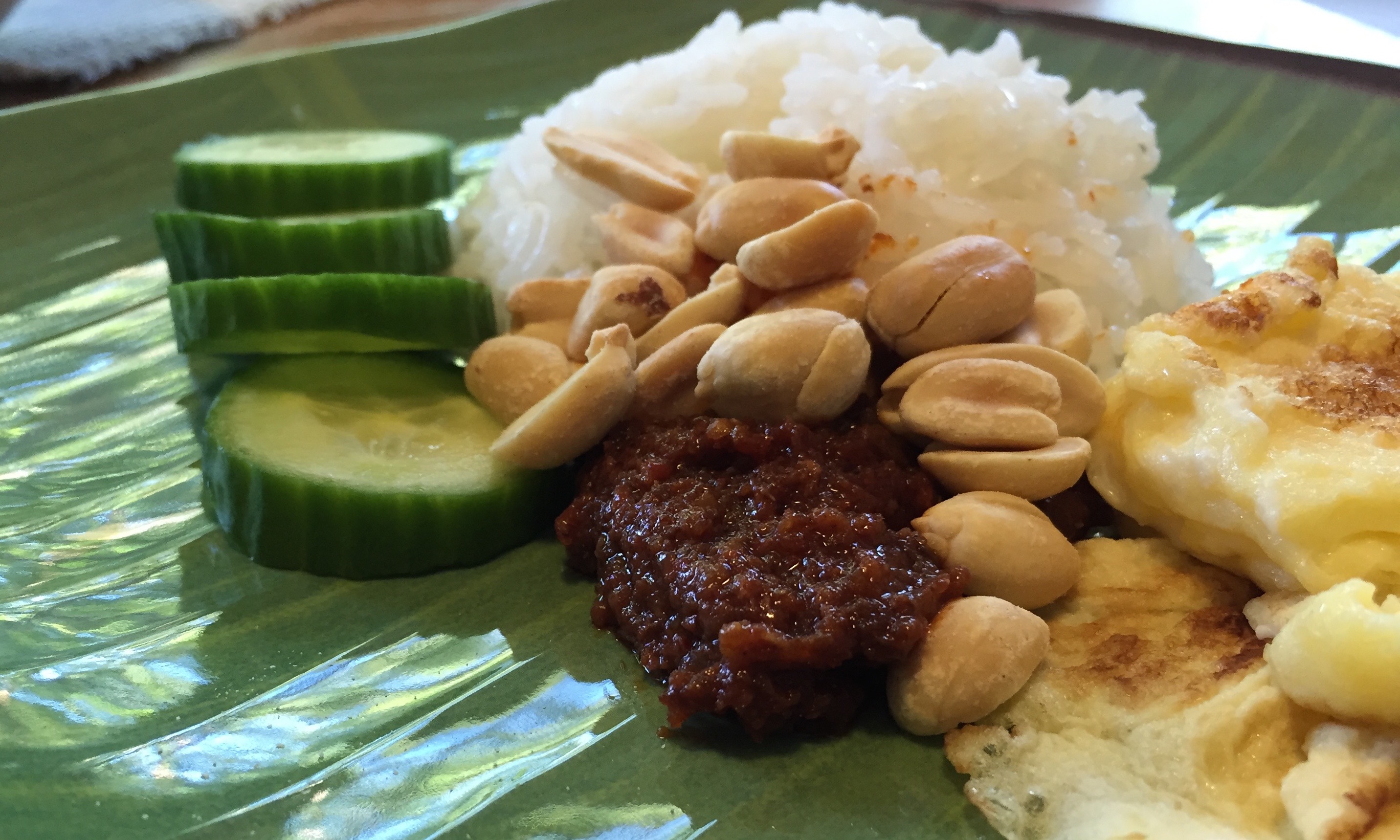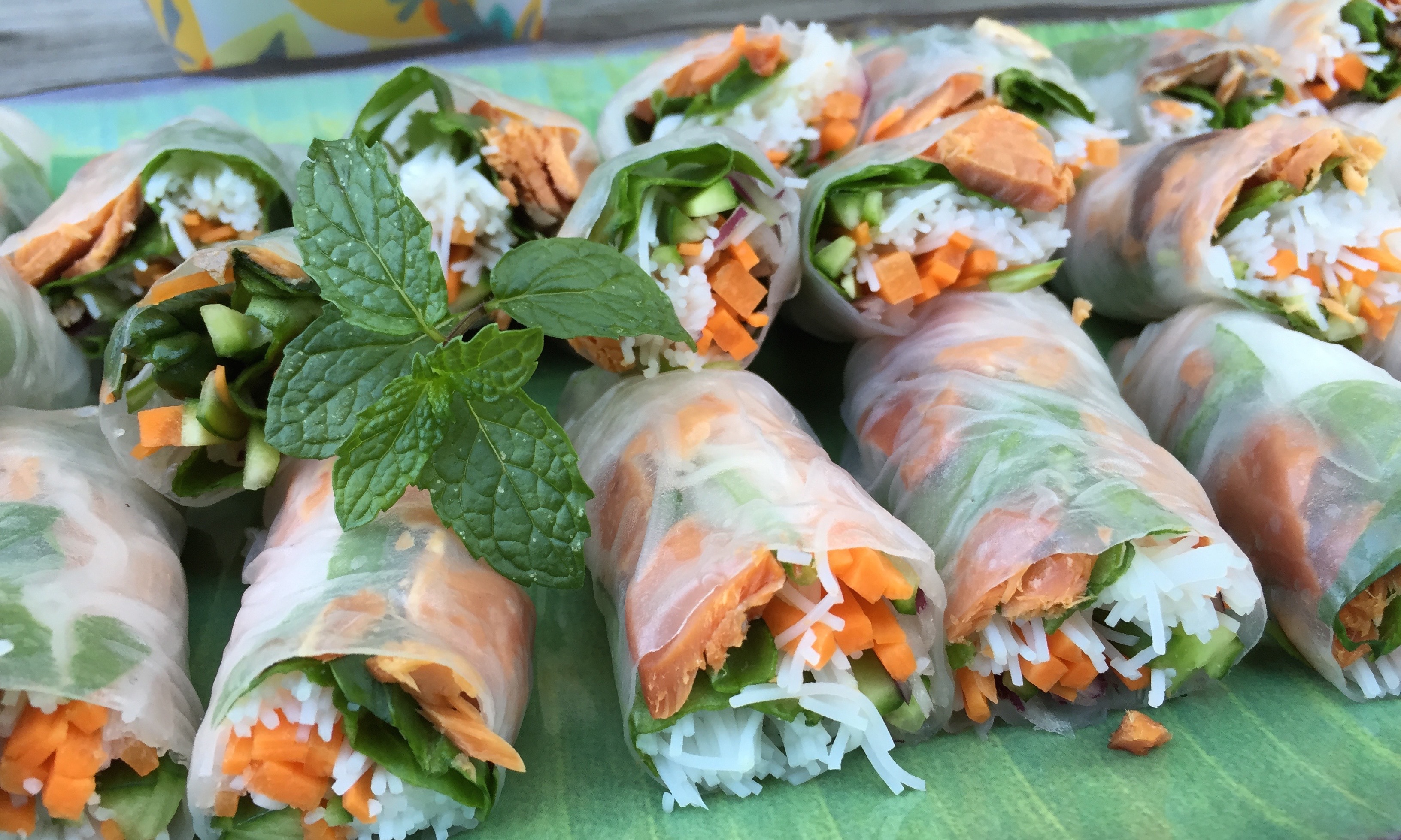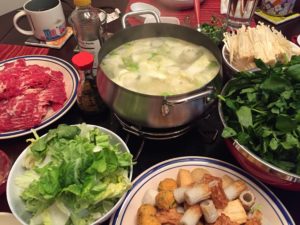
Huo Guo is something we enjoy in winter, the perfect meal for a wintry night. I began this post when winter started and now it seems spring has sprung. Or, well, winter has returned again here in the east coast! Our DC cherry blossoms have bloomed! I better get this done before it gets too warm.
Huo Guo or Hot Pot is the Chinese version of fondue, or shabu shabu. A pot of boiling stock sits in the middle of the table surrounded by a wide variety of meat and vegetables. Diners put in whatever they fancy, wait for it to cook or heat up and dish it out. Then they eat it as is, or dip it in a sauce. It is a great meal for two, or four, or 10 people.
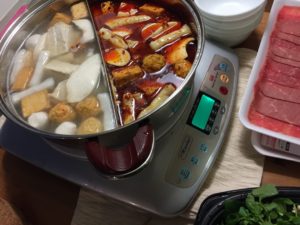 What’s the appeal? Basically, it’s just boiled meat and vegetables. Sometimes, pork or chicken stock is used. We just love the dipping sauces they come with. There are also “ying-yang” pots that have dividers right in the middle so you can have a spicy Sichuan stock next to one regular stock. (Picture right.) You cook them in different flavors in one meal. This one was enjoyed at my friend Chi’s home.
What’s the appeal? Basically, it’s just boiled meat and vegetables. Sometimes, pork or chicken stock is used. We just love the dipping sauces they come with. There are also “ying-yang” pots that have dividers right in the middle so you can have a spicy Sichuan stock next to one regular stock. (Picture right.) You cook them in different flavors in one meal. This one was enjoyed at my friend Chi’s home.
In Singapore we also have a delicious hot pot made with a spicy satay sauce. Singapore doesn’t have a cold season –the weather is hot and hotter. We enjoy hot pot–da peen lo or Steamboat as we call it–all year round. Our 90-degree weather never stopped us from communal cooking over a steamy pot.
I remember in my childhood going to this fabulous bungalow home on the beach in the east coast of Singapore. (This was decades before Singapore’s Changi airport was built.) It was one of many huge bungalows along that quiet stretch of road. The homes around there were rumored to be summer homes of wealthy Hong Kong businessmen for their mistresses. Many were used as restaurants and mahjong houses when they were no longer in use. Large round tables were set up on the spacious garden lawn of that grand old house and we ate by the seaside hearing the sea waves nearby. This restaurant was known by it’s romantic name, Wyman’s Haven.
 Their specialty was their delicious beef like the one shown here, We dipped the raw meat into the steamboat, a pot heated with burning charcoals. At the end of the meal after we had cooked shrimp and pork the stock was rich and tasty. Mum would beat a raw egg into it and place a rice bowl over the tall funnel of the pot to extinguish the fire. And we would scoop up the soup until nothing was left in the pot.
Their specialty was their delicious beef like the one shown here, We dipped the raw meat into the steamboat, a pot heated with burning charcoals. At the end of the meal after we had cooked shrimp and pork the stock was rich and tasty. Mum would beat a raw egg into it and place a rice bowl over the tall funnel of the pot to extinguish the fire. And we would scoop up the soup until nothing was left in the pot.
This was where I also learned to delight in roast pigeon. It was the best meal a child could learn to enjoy.
In Hong Kong, Taiwan and China, Huo Guo is seasonal, enjoyed in winter. In Taiwan I learned to eat Huo Guo with Sha Cha Jiang, their favorite dipping sauce in Huo Guo. The Taiwan people refer to this as satay sauce and barbecue sauce. For more on Sha Cha Jiang, click here.
Basic to Banquet
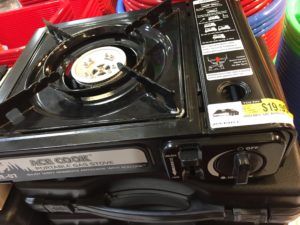 You can transform something as easy as boiling meat and vegetables to an elaborate dinner party. All hot pots offer a variety of ingredients; you take your pick. In Taiwan I learned to do this the simple way.
You can transform something as easy as boiling meat and vegetables to an elaborate dinner party. All hot pots offer a variety of ingredients; you take your pick. In Taiwan I learned to do this the simple way.
You will need a little stove that you can put in the middle of the table. My daughter uses her fondue pot, as shown in the featured photo. Some people use a rice cooker.
I think a little gas cooker that uses a canned gas canister is a good investment. They sell them for about $20 in Asian supermarkets. If I ever video my cooking, I’d use it. You can use it for cooking outdoor. I use this stove on my deck when I fry shrimp paste. While it tastes heavenly, shrimp paste leaves an odor that permeates the house. It will also come in useful during a power failure! (My Singapore friends won’t understand who has power failure. We in the U.S. do.)
Choosing the ingredients
Back in my old days in Singapore, we used to painstakingly slice our own beef, chicken, pork and peel the prawns and clean the squid and present these raw ingredients to the table.
Today I take the short cut and buy shabu shabu or bulgogi meat cuts from our Korean supermarkets. You can select pork or beef, with all different kinds of cuts. Frozen or chilled beef, prime or choice, rib eye or round, the list is generous. Same with pork, the selection is also good.
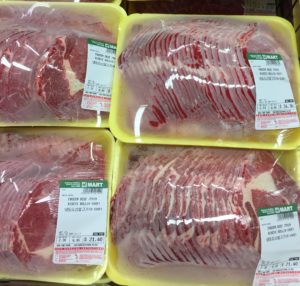
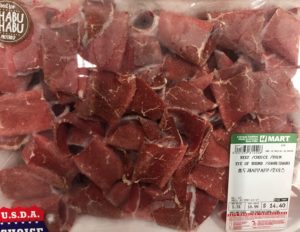

I usually thaw frozen shrimp that has been peeled and deveined. Also you can buy a cod steak and slice it into quarter-inch slices.
As well I learned in Taiwan to add all sorts of fish cake into Huo Guo. Fish cake is delicious–I’m not sure of its nutritive value–but it is fish added to corn starch and molded into a kind of meat ball in shapes of patties, rolls, fish balls, and squares. Step to the chilled or frozen area of any Asian supermarket and you’ll see shelves and shelves of a rich variety of fish cake. You can also select squid balls, beef balls, beef tendon balls.Try them. They are very good.
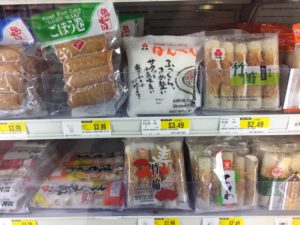
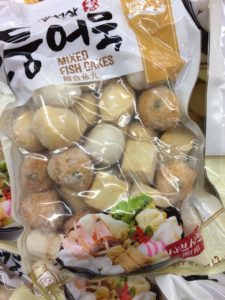
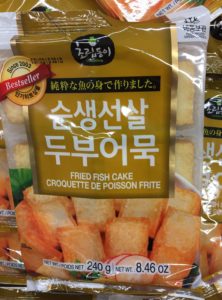

Add in vegetables. In Taiwan the favorite vegetable in Huo Guo is Napa cabbage. In Singapore it is tong ho (garland or Vietnamese chrysanthemum), a vegetable that I’ve only seen sold in Chinese supermarkets. Here it is.
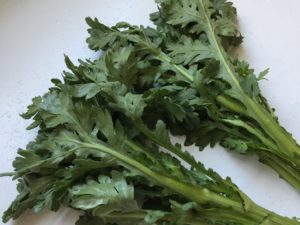
My daughter loves watercress. But you can also add spring onions, sweet corn cut into quarters, enoki mushrooms.

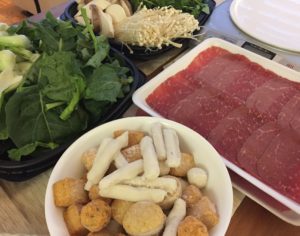
Other ingredients that are popular are different kinds of noodles and tofu. You can use udon, rice vermicelli or bean thread noodles, soaked to soften. Any of these tofu may be used–the regular silken or hard tofu, frozen tofu (which you can easily make by merely freezing tofu and then thawing it before use) and also fried tofu.
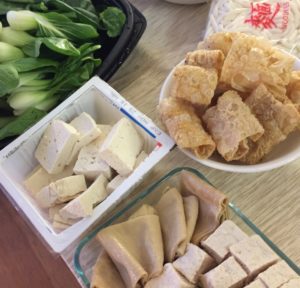
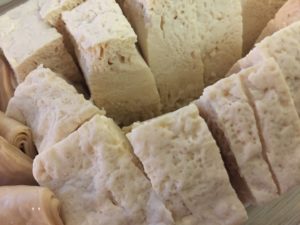
Dipping sauce
You can take the easy way out and buy a can of Sha Cha Jiang, or use your favorite chili sauce. Also offer sesame oil and soy sauce at the table.
Here is where you can be creative and come up with your own mixing sauce. In Singapore I remember that they love to use garlic chili, the kind used in Singapore’s Chicken Rice. (Maybe that is because one of the many favorite places I went to for Steamboat also served Chicken Rice.)
 What I do at my Huo Guo parties is to offer Deep Fried Garlic, and also my favorite Cantonese Ginger Scallion Sauce. Easy to make, they are popular with my guests. I encourage my guests to combine Sha Cha Jiang with fried garlic and ginger scallion sauce, soy sauce and sesame oil. The Sha Cha Jiang is a grainy and a rich, spicy shrimp-based sauce, the garlic adds a crunch and deep garlic taste, and the spring onion and ginger adds a fresh twist. Such a rich dipping sauce.
What I do at my Huo Guo parties is to offer Deep Fried Garlic, and also my favorite Cantonese Ginger Scallion Sauce. Easy to make, they are popular with my guests. I encourage my guests to combine Sha Cha Jiang with fried garlic and ginger scallion sauce, soy sauce and sesame oil. The Sha Cha Jiang is a grainy and a rich, spicy shrimp-based sauce, the garlic adds a crunch and deep garlic taste, and the spring onion and ginger adds a fresh twist. Such a rich dipping sauce.
In Taiwan, we crack a raw egg to the Sha Cha sauce, an influence of Japanese sukiyaki. The raw egg is delicious but since returning to the U.S. I avoid raw egg altogether. I don’t want to give my diners salmonella poisoning.
Presentation
With the amount of food that is suggested, what makes this simple–boil-and-eat meal–may be presented as a lavish banquet by presenting the different raw meat in separate platters, the vegetables in bamboo baskets and everything else neatly and decoratively plated. The dining table is completely filled with food and all the necessary cooking utensils. It’s a splendid sight.

Huo Guo (Taiwan-style Hot Pot)
For 10 people
Preparation time: 30-40 minutes. (Cooking is done at the table.)
Suggested meat, seafood and meat products
1 pound beef top sirloin or rib eye, thinly sliced
8 ounces pork, thinly sliced
8 ounces fish, sliced (optional)
8 ounces prawns, peeled and deveined
2 pounds assorted beef ball, squid balls, fish balls or/and fish cake
Suggested vegetables
1 pound Napa cabbage, sliced
1 pound garland chrysanthemum (tong ho)
1 pound watercress
8 ounces spring onions, cut in strips
8 ounces enoki mushrooms, separated in small bunches
Other ingredients
1 package tofu puffs
1 package soft tofu, sliced in cubes
2 small bundles bean thread noodles, softened in warm water and drained
4 quarts hot chicken stock, canned or bouillon
Hot water
Condiments for Taiwan-style dipping sauce
1 small jar Sha Cha Jiang
Soy sauce
Sesame Oil
Ginger Scallion Sauce (For recipe, click here.)
Deep fried garlic (For recipe, click here.)
Preparing the food
Wash vegetables, drain in baskets or colander that can be presented at table. Place pre-sliced meat, fish and fish cake products on separate large platters. Enoki mushrooms and spring onions placed with prawn or meat look appealing. If preparing hours ahead, plastic wrap platters and refrigerate until ready for use.
Setting up
For the table: Place the portable gas or electric stove in the center of table. Provide several slotted and soup ladles. Wooden chopsticks to handle raw meat.
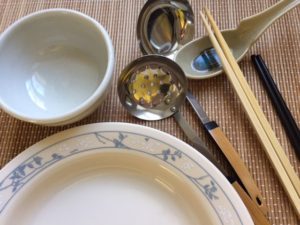
For each place setting: 1 deep plate for cooked food; 1 small bowl for dipping sauce and soup later; 1 ladle and 1 slotted ladle, wooden chopsticks; and a soup spoon. If you don’t have enough slotted ladle, provide them for communal use.
Set the table and place settings before guests arrive. Condiments may be put on a tray and set aside to make more room at the table. Your guests will be mixing their own individual dipping sauce at dinner.
Making the stock
About 20 minutes before dinner begins, heat stock in a large stockpot over kitchen stove and leave it on a simmer until ready to serve. Add stems of Napa cabbage and some fish balls or fish cake items to cook in the stock. Transfer half the stock to the hot pot at the table with some cooked food to start the feast. Save rest of stock for refilling.
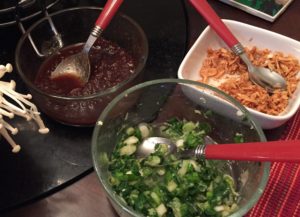 While stock is heating up, settle guests. Have each guest make his or her own dipping sauce. I usually lead by example but they can mix and experiment with whatever they like.
While stock is heating up, settle guests. Have each guest make his or her own dipping sauce. I usually lead by example but they can mix and experiment with whatever they like.
Bring out the platters of food. Your table might not have enough room for everything. Don’t put all the food out at one go but do offer a fair selection. Keep some dishes as a surprise and replenish when baskets and plates are emptied.
Dip in! Encourage guests to add their choice of food into the pot, cook and serve themselves. Dunk hot cooked food in sauce and enjoy. Typically, we end the meal by adding noodles to the broth but there is no hard and fast rule on what goes in when.
